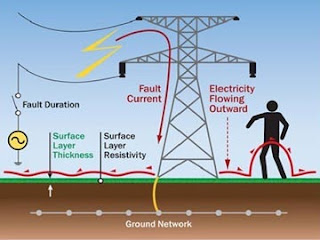Q.1 Plate earthing and pipe earthing are used where the soil is___.
A. Comparatively rocky
B. Comparatively soft
C. comparatively sandy
D. all of the above
Ans.: B
Q.2 The value of the earth resistance decreases as the electrodes are connected in__.
A. series
B. parallel
C. series-parallel
D. none of the above
Ans.: B
Q.3 The value of earth resistance is _____ to the square of the distance.
A. directly proportional
B. inversely proportional
C. not defined
D. none of the above
Ans.: B
Q.4 As the distance from the electrode increase, the earth resistance___
A. increases
B. decrease
C. cannot change
D. none of the above
Ans.: B
Q.5 Earth resistance should be _____ when the capacity of the equipment is ___.
A. more, more
B. less, less
C. more, less
D. less, more
Ans.: D
Q.6 Which of the following is correct as the maximum permissible earthing resistance for different installation as per Indian electricity rules.
A. small substation = 2.00 ohms
B. Domestic installation = 8.00 ohms
C. big power station or substation = 1.00 ohms
D. all of the above
Ans.: D
Q.7 Which of the following factors increase the earth resistance?
A. reduced amount of moisture in soil
B. rust between joints
C. loose connections
D. all of the above
Ans.: D
Q.8 Less contact is made when the connection is loose so the ____.
A. resistance decreases
B. moisture increases
C. resistance increases
D. Temperature of the contact increases
Ans.: C
Q.9 Rust is developed at the joint due to___.
A. the moisture in the atmosphere
B. if the plate or rod buried in earth
C. due to loose contact
D. Both A and B
Ans.: D
Q.10 The earth resistance in summer season as compared to monsoon season is__.
A. more
B. less
C. equal in both the season
D. Cant defined
Ans.: A
Q.11 which of the following methods are used to measure the earth resistance?
A. Voltmeter-ammeter method
B. Earth loop tester and earth tester method
C. ohm meter method
D. all of the above
Ans.: D
Q.12 Earth tester is an instrument to measure __.
A. high resistance
B. low resistance
C. medium resistance
D. extra high resistance
Ans.: B
Q.13 ____ is used to measure earth loop resistance between the substation and place of use.
A. voltmeter-ammeter method
B. Ohms meter method
C. Loop tester method
D. none of the above
Ans.: C
Q.14 Many times static electric charges are produced due to friction between the two rotating parts which produces potential difference between these two parts. These two are joined by a flexible conductor is called as___.
A. Grounding
B. welding
C. bonding
D. soldering
Ans.: C
Q.15 Earthing of the following parts should be done in substation and generating station:
A. Metal framework not related to power system such as steel structure
B. Equipments related to each system such as framework, non conducting parts
C. Neutral point of systems of different voltages
D. all of the above
Ans.: D
